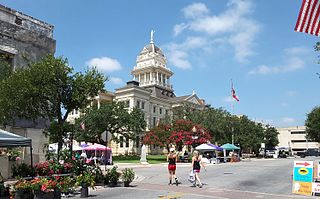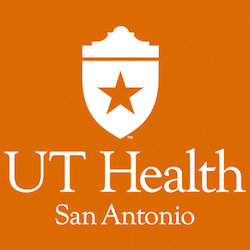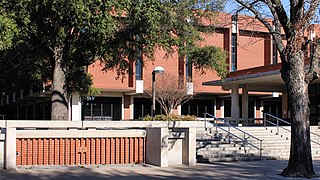
Belton is a city in the U.S. state of Texas, within the Killeen-Temple metropolitan area. The city is on the Interstate 35 corridor between Austin and Waco and is the seat of Bell County.The population was 21,734 in 2017 according to a US Census Estimate. As of 2015 the metro region had a population of 450,051.

Temple is a city in Bell County, Texas, United States. As of 2018, the city has a population of 76,600 according to a US census estimate.

Waco is a city in central Texas and is the county seat of McLennan County, Texas, United States. It is situated along the Brazos River and I-35, halfway between Dallas and Austin. The city had a 2010 population of 124,805, making it the 22nd-most populous city in the state. The 2018 US Census population estimate is 138,183 The Waco Metropolitan Statistical Area consists of McLennan and Falls Counties, which had a 2010 population of 234,906. Falls County was added to the Waco MSA in 2013. The 2018 US Census population estimate for the Waco MSA is 271,942.

The University of Texas Health Science Center at San Antonio is a public academic health science center in San Antonio, Texas. It is part of the University of Texas System.

James Connally Air Force Base was a United States Air Force base located north of Waco, Texas. After its closure in 1968, the airport reopened as TSTC Waco Airport.

The Beck Group is a company that provides architecture, construction, real estate development and sustainable design and consulting, as well as finance and technology services. The company is based in Dallas, Texas and also has offices in Atlanta, Austin, Denver, Fort Worth, Houston, Mexico City, Monterrey Mexico, San Antonio, and Tampa. The Beck Group serves a diverse range of industries, including corporate, healthcare, entertainment, religious, and education, with sustainability as an emphasis. They also provide services based on the use of their software product, DESTINI.

Alexander James Moore Academy was a magnet high school in the Waco ISD district in Waco, TX. A.J. Moore was designed to prepare students for success in post secondary education and in the workplace. Students were prepared to excel academically, physically and socially. Special emphasis was placed on business, engineering, entrepreneurship, technology, and post-secondary education. In February 2012, the Waco Independent School District decided in part, avoiding a $3.4 million budget shortfall, to close and consolidate A. J. Moore Academy with University High School. On June 2, 2012, A.J. Moore Academy gave diplomas to its last graduating class. A. J. Moore Academy existed as a stand-alone school for 14 years.

Baylor University, or simply Baylor, is a private Baptist Christian university in Waco, Texas. Chartered in 1845 by the last Congress of the Republic of Texas, it is the oldest continuously operating university in Texas and one of the first educational institutions west of the Mississippi River in the United States. Located on the banks of the Brazos River next to I-35, between the Dallas-Fort Worth Metroplex and Austin, the university's 1,000-acre campus is the largest Baptist university campus in the world. Baylor University's athletic teams, known as the Bears, participate in 19 intercollegiate sports. The university is a member of the Big 12 Conference in the NCAA Division I.

The Waco Mammoth National Monument is a paleontological site and museum in Waco, Texas, United States where fossils of 24 Columbian mammoths and other mammals from the Pleistocene Epoch have been uncovered. The site is the largest known concentration of mammoths dying from a (possibly) reoccurring event, which is believed to have been a flash flood. The mammoths on site did not all die at the same time but rather during three separate events in the same area. A local partnership developed around the site after the initial bone was discovered. The Waco Mammoth Foundation worked in partnership with the city of Waco and Baylor University to develop the site. Baylor's involvement mainly included the research, preservation, and storage of materials from the site, while the city of Waco contributed to the protection of the land. In 2015, they successfully sought the National Monument designation to bring the expertise of the National Park Service into the partnership.
The National Space Biomedical Research Institute (NSBRI) is a NASA-funded consortium of institutions studying the health risks related to long-duration spaceflight and developing solutions to reduce those risks. The NSBRI was founded in 1997. NSBRI's 16,400-square-foot headquarters facility is located in the BioScience Research Collaborative in Houston, Texas. The Institute shares the facility with Baylor College of Medicine's Center for Space Medicine. The official opening was held March 19, 2012.
The Texas Hunger Initiative (THI) is a capacity-building, collaborative project dedicated to developing and implementing strategies to end hunger through policy, education, research, community organizing and community development. THI convenes federal, state and local government stakeholders with nonprofits, faith communities and business leaders to create an efficient system of accountability that increases food security in Texas.

Moody Memorial Library is one of the two central libraries at Baylor University located in Waco, Texas. Jesse H. Jones Library is connected to Moody by two hallways and serves as the second of the two central libraries at Baylor. Moody is the larger of the two central libraries.

Jesse H. Jones Library is one of the central libraries at Baylor University in Waco, Texas. Built in 1992, Jones is smaller than the other central library, Moody Memorial Library. Jones connects with Moody by way of hallways on both the first and second floors.
The Texas Collection is one of the special libraries at Baylor University in Waco, Texas. Situated in the Carroll Library Building, the Texas Collection serves as a collection of various documents, items and artifacts significant to Texas history.
McMaster Innovation Park is an innovation and research facility located approximately 2 kilometers from McMaster University in Hamilton, Ontario. McMaster Innovation Park's focuses on supporting startups, business, research through providing property management services as well as business aid. Entrepreneurs, firms, researchers, industry partners, business mentors and support facilities are the main customers of the firm. MIP currently houses four buildings: the Atrium@MIP, CanmetMATERIALS, McMaster Automotive Resource Centre (MARC), Biomedical Engineering and Advanced Manufacturing (BEAM) project centre and envisions 10 buildings on site within 10 years with 1,500-1,800 people working full-time.

Research Park at the University of Illinois at Urbana–Champaign is a research park located in the southwest part of the University of Illinois at Urbana–Champaign campus in Champaign, Illinois. Research Park is a technology hub for startup companies and corporate research and development operations. Within Research Park there are more than 120 companies employing more than 2,100 people including students and full-time technology professionals.
The 'Engineering, Science & Technology Entrepreneurship Excellence Masters Program' also known as the 'ESTEEM Program' is an entrepreneurship master's program and collaborative effort between the Mendoza College of Business, College of Science, and College of Engineering at the University of Notre Dame. The 1-year program includes business courses covering finance, marketing, strategy, leadership, project management, quality, operations research, and ethics as well as science and/or engineering electives and a capstone thesis project.

The BioScience Research Collaborative (BRC) is a collaborative life science research building in the Texas Medical Center in Houston, Texas. It is similar in concept to the Clark Center/BioX at Stanford University and the Broad Institute at MIT, among other collaborative centers. After Rice University President David Leebron announced his "Vision for the Second Century," including plans to increase research funding, build up existing programs, and increase collaboration between Rice and other entities, the construction of the BRC went forward with the intention of fostering collaboration with the neighboring Texas Medical Center. The BRC was built by Rice University, and officially opened in April 2010. A unique characteristic of the BRC as compared to other academic research institutes is the shared research space by faculty from Rice University and groups from neighboring Texas Medical Center institutions. Collaborative research provides an advantage over traditional research in that multiple professors, or principal investigators, and their laboratory groups work together on different aspects of the same problem which usually results in finding a solution in a shorter amount of time.,
Bluebonnet Ordnance Plant was a munitions plant near McGregor, Texas, which manufactured TNT, bombs, ammonium nitrate and similar products for the American troops during World War II. BlueBonnet Ordnance Plant was one of four ordnance plants in the United States during World War II.













